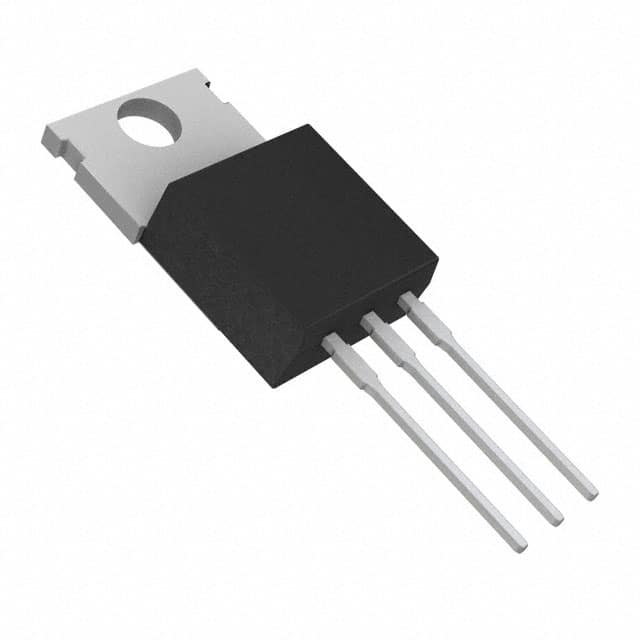2N6045G
Product Overview
Category:
The 2N6045G is a high-power NPN silicon transistor.
Use:
It is commonly used in power amplifier and switching applications.
Characteristics:
- High power handling capability
- Low collector-emitter saturation voltage
- Fast switching speed
Package:
The 2N6045G is available in a TO-220 package.
Essence:
This transistor is designed to handle high power levels with low saturation voltage, making it suitable for power amplification and switching applications.
Packaging/Quantity:
The 2N6045G is typically sold in reels or tubes containing multiple units.
Specifications
- Collector-Emitter Voltage (VCEO): 100V
- Collector Current (IC): 15A
- Power Dissipation (PD): 150W
- DC Current Gain (hFE): 20-70
- Transition Frequency (fT): 3MHz
Detailed Pin Configuration
The 2N6045G transistor has three pins: the emitter, base, and collector. The pinout configuration is as follows: - Emitter (E) - Pin 1 - Base (B) - Pin 2 - Collector (C) - Pin 3
Functional Features
The 2N6045G offers the following functional features: - High power handling capability - Fast switching speed - Low saturation voltage
Advantages and Disadvantages
Advantages
- High power handling capability
- Low collector-emitter saturation voltage
- Fast switching speed
Disadvantages
- Relatively low DC current gain compared to some alternative models
- Limited frequency response for high-frequency applications
Working Principles
The 2N6045G operates based on the principles of NPN transistor amplification and switching. When biased correctly, it allows for the control of high-power circuits and signals.
Detailed Application Field Plans
The 2N6045G is commonly used in the following application fields: - Power amplifiers - Switching circuits - Motor control systems - Voltage regulators
Detailed and Complete Alternative Models
Some alternative models to the 2N6045G include: - TIP3055 - MJ15003 - MJE3055
In conclusion, the 2N6045G is a high-power NPN silicon transistor with characteristics that make it suitable for power amplification and switching applications. Its high power handling capability and low saturation voltage are key advantages, while its limited frequency response and relatively low DC current gain are potential disadvantages. It finds common use in power amplifiers, switching circuits, motor control systems, and voltage regulators. Alternative models such as the TIP3055, MJ15003, and MJE3055 offer similar functionality and can be considered as substitutes for the 2N6045G in various applications.
Lista 10 Vanliga frågor och svar relaterade till tillämpningen av 2N6045G i tekniska lösningar
What is the 2N6045G transistor used for?
- The 2N6045G is a high-power NPN bipolar junction transistor (BJT) commonly used in power amplifier and switching applications.
What are the key specifications of the 2N6045G?
- The 2N6045G has a maximum collector current of 15A, a maximum collector-emitter voltage of 80V, and a maximum power dissipation of 150W.
Can the 2N6045G be used in audio amplifier circuits?
- Yes, the 2N6045G can be used in audio amplifier circuits due to its high power handling capability and suitable characteristics for audio applications.
Is the 2N6045G suitable for motor control applications?
- Yes, the 2N6045G can be used in motor control applications where high current and voltage requirements are necessary.
What are the typical operating conditions for the 2N6045G?
- The 2N6045G operates typically at a collector current of 7A, a collector-emitter voltage of 40V, and a base current of 1.5A.
Can the 2N6045G be used in high-frequency applications?
- The 2N6045G is not typically recommended for high-frequency applications due to its slower switching speeds compared to specialized high-frequency transistors.
What are the common failure modes of the 2N6045G?
- Common failure modes include thermal runaway under high load conditions and breakdown due to excessive voltage or current.
Are there any specific heat dissipation requirements for the 2N6045G?
- Proper heat sinking is essential for the 2N6045G, especially when operating at high currents or in high ambient temperature environments.
Can the 2N6045G be used in parallel to increase current handling?
- Yes, the 2N6045G can be used in parallel to increase the overall current handling capability in high-power applications.
Are there any recommended alternative transistors to the 2N6045G?
- Alternative transistors with similar characteristics include the MJL21193 and MJL21194, which are also high-power NPN transistors suitable for similar applications.


